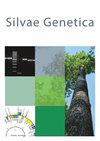Towards new seed orchard designs in Germany – A review
IF 1
4区 农林科学
Q3 FORESTRY
引用次数: 9
Abstract
Abstract New first and 1.5 generation seed orchards are to be created in Germany based on recently assembled breeding populations of Acer pseudoplatanus, Larix sp., Picea abies, Pinus sylvestris, Pseudotsuga menziesii, and Quercus sp. To justify the high expenses in time and cost for orchard establishment and maintenance, planning should make use of consolidated knowledge and experience of both the national and international scientific community. Here, we briefly describe advances in genetic gains achieved through tree breeding, and resume population genetic aspects and design considerations to draw conclusions for clonal composition and spatial design of the new orchards. We conclude that to avoid outbreeding depression separate orchards are required for each breeding zone. The zones are species-specific and defined by ecological and climatic aspects. A minimum of 60-80 clones per orchard is recommended for native tree species with high proportions of natural regeneration in forest practice. This would allow future selective thinning based on estimated breeding values from progeny testing. It would also permit the transfer of seed orchard progenies into a naturally regenerating forest stands without the risk of a genetic bottleneck. Lower clone numbers are appropriate for non-native species and hybrids. It is important to strictly avoid inbreeding depression, achieved by using only one clone per progeny or population, from which the plus trees were selected. Further, the spatial layout should promote random mating by optimizing the neighbourhood of each clone. With all of these considerations taken into account, we expect superior quality traits and at least 10-15 % more volume from the new seed orchards.德国新种子园设计——综述
摘要:德国拟建立第一代和第1.5代种子园,其基础是最近聚集的pseudoplatanus Acer、Larix sp.、Picea abies、Pinus sylvestris、Pseudotsuga menziesii和Quercus sp.的育种群体。为了证明果园建设和维护的高时间和成本是合理的,规划应利用国内和国际科学界的综合知识和经验。在这里,我们简要介绍了通过树木育种取得的遗传增益的进展,并恢复了群体遗传方面和设计考虑因素,以得出新果园克隆组成和空间设计的结论。我们认为,为避免近交萧条,每个繁殖区需要单独的果园。这些区域是物种特有的,由生态和气候方面来定义。在森林实践中,对于自然更新率高的原生树种,建议每个果园至少有60-80个无性系。这将允许未来根据从后代测试中估计的育种值进行选择性减种。它还允许将种子果园的后代转移到自然再生的森林中,而不会有遗传瓶颈的风险。较低的克隆数适合于非本地物种和杂交种。重要的是要严格避免近交萧条,每个后代或群体只使用一个无性系,从中选择正树。此外,空间布局应通过优化各无性系的邻域来促进随机交配。考虑到所有这些因素,我们预计新种子园的品质会更好,产量至少会增加10- 15%。
本文章由计算机程序翻译,如有差异,请以英文原文为准。
求助全文
约1分钟内获得全文
求助全文
来源期刊

Silvae Genetica
农林科学-林学
CiteScore
2.20
自引率
10.00%
发文量
10
审稿时长
3 months
期刊介绍:
Silvae Genetica is an international peer reviewed journal with more than 65 year tradition and experience in all fields of theoretical and applied Forest Genetics and Tree breeding. It continues "Zeitschrift für Forstgenetik und Forstpflanzenzüchtung" (Journal of Forest Genetics and Forest Tree Breeding) founded by W. LANGNER in 1951.
 求助内容:
求助内容: 应助结果提醒方式:
应助结果提醒方式:


